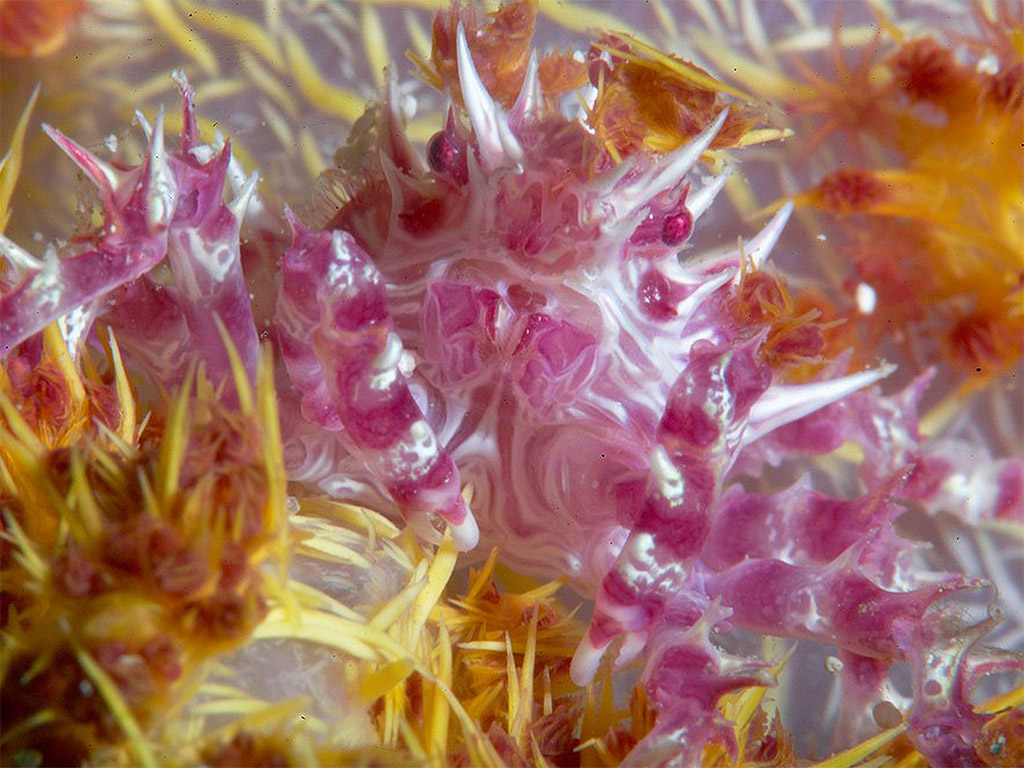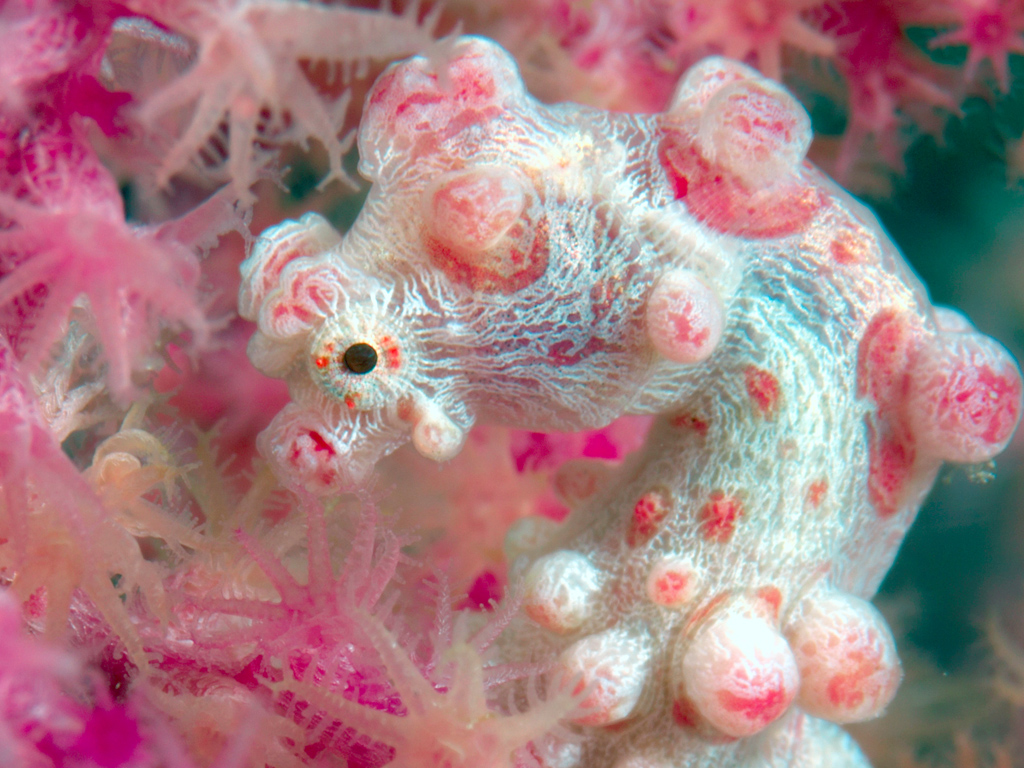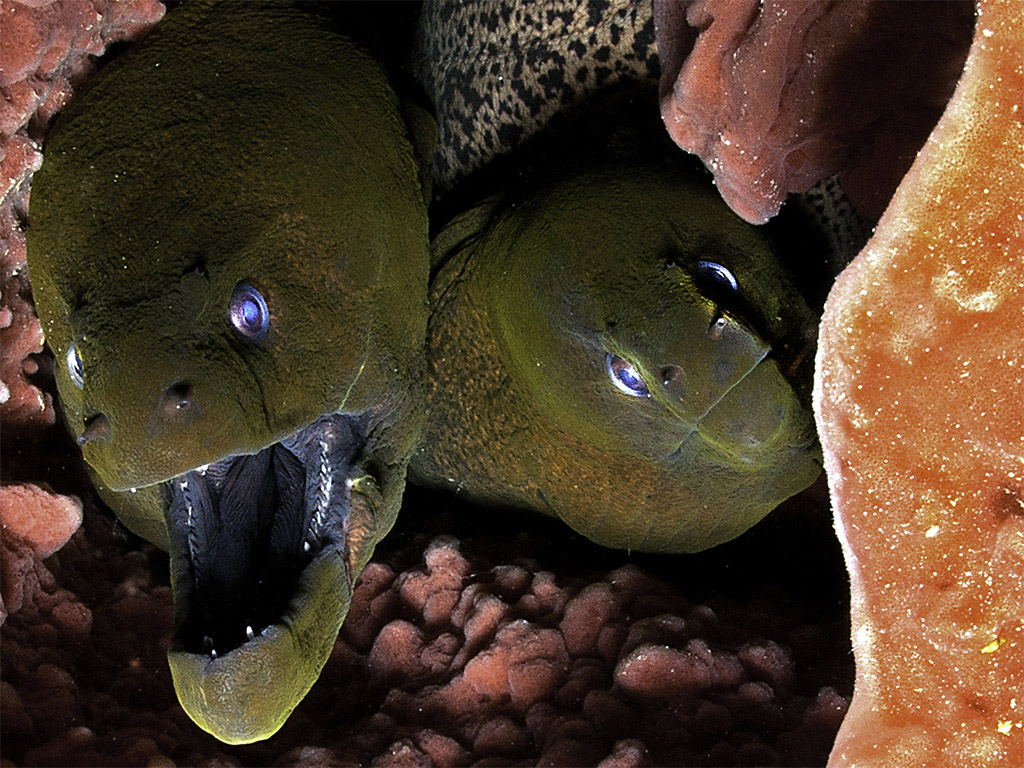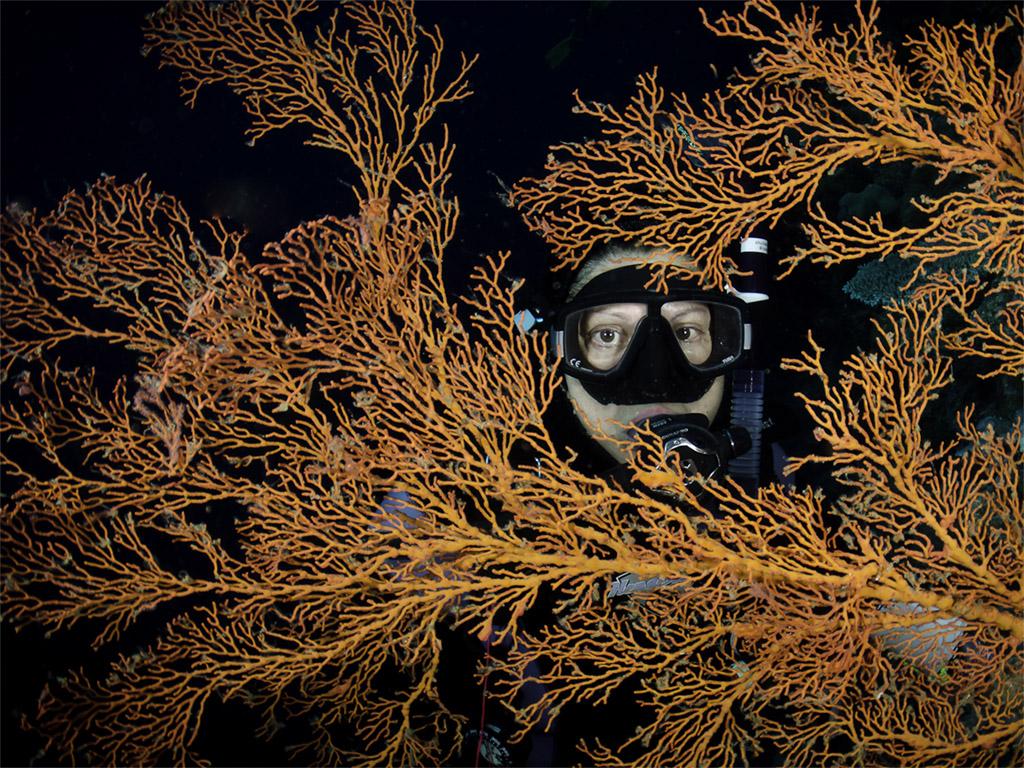Majestic Hiding Places
The coral reefs of Wakatobi are so rich with corals, sponges and marine organisms, that the vast majority of creatures are not immediately visible. Camouflaged and hidden amongst the myriad vibrant colors and shapes of the reef, sometimes the impatient amongst us are lead to move quickly and even wonder where all the creatures actually are. Slow down, look closer! You will surely find hiding among the sponges, sea fans, crinoids, and in the rubble some of the coral reefs’ majestic hiding places and the creatures that inhabit them.
Coral reefs support over twenty-five percent of all known marine species. As one of the most complex ecosystems on the planet, coral reefs are home to over 4,000 different species of fish, 700 species of coral and thousands of other plants and animals. The corals themselves are perhaps the most majestic hiding places of all, with many creatures looking as if they ‘are’ the corals. Again, stop, look closely… and look again!
The soft coral crab lives as a commensal on beautiful, delicate soft coral branches. The tiny crab doesn’t have many options other than hiding into a soft coral branch, so to do this, he gathers some of the host’s tiny polyps, or even branches, and puts them on top of his body, so to blend perfectly with his host!

The soft coral crab lives as a commensal on beautiful, delicate soft coral branches. (photo by Eric Cheng)
The tiny soft coral crab can be seen in detail in this extremely close macro shot. The fragile, beautiful soft coral colonies are branched, with stems emerging from a central trunk. The stem is white or transparent, with sclerites embedded in the tissues. The polyps appear in cluster at the tips of the branches. Polyps are tiny, only about 0.5cm with eight branched tentacles. Their polyps may be white, beige, yellow, orange to purple and brown. The sclerites in the polyps give the colony a spiky appearance. The spikes are more obvious when the polyp tentacles are retracted and the polyps curl into little balls and this is where the soft coral crabs can be found. Soft Coral Crabs take on the colour of their associated soft coral. They can feed on coral polyps, are very well camouflaged and hard to spot unless on a night dive at Wakatobi, when they actively move around the spiky soft coral.
Where better to start than with the corals themselves! The ‘spanish dancer’ nudibranch (Hexabranchus sanguineus) merges into the colourful coral. Yet when it moves, it dances, gently waving its edges like a flamenco dancer.
Looking more closely between the corals, let’s start with the sponges as next on our list of majestic hiding places. Sponges need healthy conditions, clear waters and a pristine ecosystem to reach the very rare, gigantic size of the sponges in Wakatobi. From octopus to fish and moray eels, many species find their home inside these magnificent sponges, where the complex canals, ridges and pores provide a perfect hiding place for shrimps, squat lobsters and the tiniest of the tiny.
Although they may look plant-like, sponges are the simplest of animals and the oldest living group of multicellular organisms, first appearing over half a billion years ago!. A sponge is a bottom-dwelling creature, which attaches itself to something solid in a place where it can, hopefully, receive enough food to grow. The scientific term for sponges is Porifera, which literally means “pore-bearing”, as sponges are covered with tiny little holes or ‘pores’ that lead internally to a system of canals and eventually out to one or more larger holes, called oscula. Within the canals, cells beat a hair-like whip or ‘flagella’ back and forth to force water through the sponge. The water brings in nutrients and oxygen, while it carries out waste and carbon dioxide and simultaneously picks up tiny bits of food brought in with the water. Sponges are very effective filter feeders, since they are able to capture and eat particles as small as bacteria as well as much larger particles.
Looking like the sponge itself, a frogfish can live in perfect camouflage. Frogfish coloration varies from species to species, and even within the same species. Textures range from smooth velvety skin, to algae covered warts, and even spots that look just like those of a sponge. The strange and extremely cryptic frogfish have adapted a very interesting way to hunt. They fish; Frogfish have a modified dorsal spine that they use as a fishing rod. For bait, they flick up and down a fleshy appendage at the end, just like a lure. When an unsuspecting fish comes in for a bite, the Frogfish opens its wide, protruding mouth, and sucks them in whole. Sometimes its prey is almost as big as the Frogfish itself. Looking just like a sponge attached to the substrate, fish are none the wiser that there is danger lurking behind the tasty looking lure. Craved by photographers, and needing sharp eyes to find, Frogfish truly are one of natures’ most bizarre creatures.
This pair of Moray eels spends most of their resting time inside the gigantic barrel sponge. Moray eels are carnivorous animals, feeding mainly on other fish. Fish such as groupers have been observed to recruit morays to join them in hunting for food or ‘group hunting’. The invitation to hunt is initiated by head shaking. The rationale for this joining of forces is the ability of morays to enter narrow crevices and flush prey from niches not accessible to groupers.
Moray eels’ heads are too narrow to create the negative pressure that most fish use to swallow prey. Quite possibly because of this, they have a second set of jaws in their throat called pharyngeal jaws, which also possess teeth. When feeding, morays launch these jaws into the mouth, where they grasp prey and transport it into the throat and digestive system. The Moray eel are the only animal that uses pharyngeal jaws to actively capture and restrain prey.
Morays are still often thought of as vicious or ill tempered, but in reality, they hide from humans in crevices and would rather flee than fight. Morays are shy and secretive, and attack humans only in self-defense or mistaken identity. Most attacks stem from disruption of a moray’s burrow and hand feeding of morays by divers, an activity often used by some dive companies to attract tourists. Morays have poor vision and rely mostly on their acute sense of smell, making distinguishing between fingers and held food difficult.
From the large to the tiny, this little hairy squat lobster is sharing the creases and crevices of the enormous barrel sponge with the moral eels. These days only seen in a few pristine locations around the world, the enormous sponges of Wakatobi are covered with innumerable holes, offering homes to many critters such as this funky Hairy Squat Lobster.
Our next hiding place for multiple amazing creatures is the Sea Fan. Sea fans are extremely slow growing and delicate and can take hundreds of years to reach a good size. Wakatobi is home to an incredible array of enormous, healthy fans, in a wide variety of colors and sizes, some reaching record sizes of several meters wide.
Sea fans are extremely fragile and can be damaged or killed easily by misplaced fins, a gauge, or by divers mistakenly putting a big camera or strobe into the fans branches. But if buoyancy is perfect, the approach made carefully, and a great deal of attention paid to make sure the fan isn’t disturbed when the diver moves backwards, numerous incredible little treats can be found living within the fans branches.
In Wakatobi, there is something so special and so unusual that it is talked about worldwide, yet never fails to inspire. Take the time to carefully, slowly approach and scan the branches of a sea fan, looking twice at each of the fan’s tiny polyps. Patience and time will often lead to the discovery of many creatures living within the fan, as well as some of Wakatobi’s infamous and minuscule residents – the tiniest seahorses in the world – the Pygmy seahorse.
Living within and appearing at first glance to actually be one of the sea fans tiny polyps, they can be easily missed, even when staring right at them. If they feel threatened, they turn their backs to divers, becoming almost impossible to distinguish from the sea fan. But if approached slowly and limiting the number of photographs and light, these tiny creatures will stay at ease and you might just get a perfect shot.

One of Wakatobi’s famous sea fan residents, the Bargibant pygmy seahorse.
photo by Wakatobi guest Richard Smith

In Wakatobi, you might find a cowry blending in on the branches of a sea fan or other hiding places on the reef.
photo by Wakatobi guest Clark Anderson
At Wakatobi, you might find a cowry blending in on the branches of a sea fan and other hiding places on the reef. Cowry or cowrie is the common name for a group of small to large sea snails, whose shells are often shaped more or less like an egg, except that they are rather flat on the underside. These attractive porcelain-like shells are striking and have long been sought for jewelry and ornamentation, making them a rare and unusual find.
There are many other Majestic Hiding Places on the reefs at Wakatobi. To learn more about diving and snorkeling at Wakatobi visit us at www.wakatobi.com.




